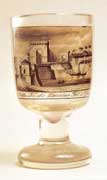|
Maria Theresa, realising the importance that Hungarian symbols of state had for the country, had Buda's Royal Palace rebuilt, returned the right hand of St. Stephen to Hungary and ennobled many Hungarians – but it was Vienna that was the seat of power, and Hungarian affairs were controlled from Pressburg (now Bratislava); Buda was really no more than a provincial outpost of the Habsburg court.  It was not until the nineteenth century that the conception of a united Hungarian capital called Budapest really took off. In the first decades of the century the great reformer Count István Széchényi undertook to shape the whole place up. Strongly Anglophile, he visited England repeatedly, and came back home full of schemes for steamships and railways on the English model. He also built the first permanent bridge over the Danube, and cut the tunnel through the Castle Hill. In 1848 the feverish spirit of nationalism which was coursing through Europe did not leave the city untouched. Anti-Habsburg feeling was stirred up on a political level by the fiery oratory of lawyer-turnedrevolutionary Lajos Kossuth, and on a popular level by the idealistic young poet Sándor Petőfi.Kossuth declared an independent Hungarian capital in the eastern town of Debrecen, while Petőfi incited the masses to revolution with his inflammatory verses. Things went Hungary's way for a while – and then Austria called in the Russians to help them deal the recalcitrant Magyars a crushing blow. Hungary cocked a snook at Austria by surrendering not to the Kaiser but to the Czar. Austria tried to quell Hungary's rebellious spirit once and for all by ignominiously hanging as many of Hungary's generals as she could get her hands on. It was not until the nineteenth century that the conception of a united Hungarian capital called Budapest really took off. In the first decades of the century the great reformer Count István Széchényi undertook to shape the whole place up. Strongly Anglophile, he visited England repeatedly, and came back home full of schemes for steamships and railways on the English model. He also built the first permanent bridge over the Danube, and cut the tunnel through the Castle Hill. In 1848 the feverish spirit of nationalism which was coursing through Europe did not leave the city untouched. Anti-Habsburg feeling was stirred up on a political level by the fiery oratory of lawyer-turnedrevolutionary Lajos Kossuth, and on a popular level by the idealistic young poet Sándor Petőfi.Kossuth declared an independent Hungarian capital in the eastern town of Debrecen, while Petőfi incited the masses to revolution with his inflammatory verses. Things went Hungary's way for a while – and then Austria called in the Russians to help them deal the recalcitrant Magyars a crushing blow. Hungary cocked a snook at Austria by surrendering not to the Kaiser but to the Czar. Austria tried to quell Hungary's rebellious spirit once and for all by ignominiously hanging as many of Hungary's generals as she could get her hands on.
|
|
|